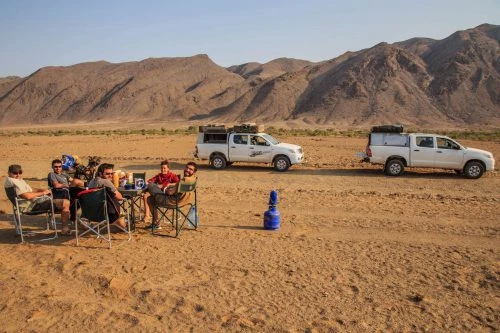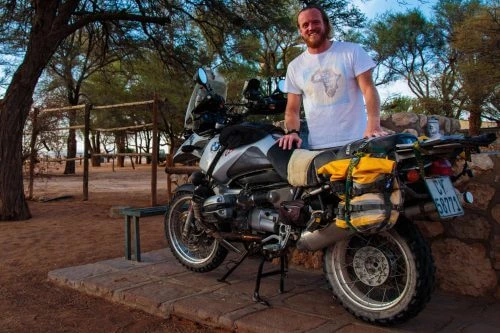Namibia
Thursday, February 16, 2017
- Three Continents
Together with Wesley the journey continued along the Zambezi river in the direction of the Namibian border. The street was littered with sloops. We invented a new sport: < Full gas sled cycling >. It feels a bit like river rafting only without water. After 2 days we reached the border to Namibia.

The border crossing went very fast and without problems I got a 3 months valid visa. Such an efficient way of working is not really used in Africa! In Katima Mulilo we were allowed to stay with Susanne and Paul for 3 days. They also work for Interteam interteam.ch. Many heartfelt thanks for the great hospitality!
On the way through the Caprivi Strip overtook us 2 German cyclists. Heinz and Bernd are cycling from Lusaka to Namibia. Caprivi was named after German Chancellor Leo von Caprivi (in office 1890–1894), who negotiated the acquisition of the land in 1890 in an exchange with the United Kingdom. Von Caprivi arranged for Caprivi to be annexed to German South-West Africa in order to give Germany access to the Zambezi River and a route to Africa’s east coast, where the German colony Tanganyika was situated.
The ride through the Bwabwata National Parc was a disappointment for me. The asphalted road is extremely narrow and on a length of 60 kilometers people live here. We saw very few animals. From my point of view this park is a joke. At the end of the park, in Divundu, I had to say goodbye to Wesley. He went on to Botswana. My plan was to continue along the Angolan border. Many thanks Wesley for the great time together with you!

The north of Namibia is in no way different from the rest of Africa. Everywhere there are clay- and corrugated huts, which are crowded with people. In addition, the people are also lighting the whole landscape. The car drivers are enormously ruthless here and drove me almost every time over the pile. I would not recommend anyone to cycle here. Most of the problems were the fly. They terrorized me all day long.
After nearly 1,200 kilometers driving through the north of Namibia, I arrived in Opuwo. I did not like the place at all. So I drove straight ahead in the direction of the Kaokoveld (Road Nr. D3707). The Kaokoveld is a harsh desert of drifting sanddunes and rocky mountains. It receives most of its rainfall during the summer. The Kaokoveld is home to a number of endemic reptiles while large mammals including desert elephants, black rhinos and giraffes visit the riverbeds.
I liked the area immediately. Finally a place in Africa where there are not so many people! Especially the beautiful landscape with its infinite silence I enjoyed very much. But also pursued me a bad luck. First I had to fight with strong diarrhea. At the end I had to take antibiotics. But this was only the beginning. My list of injuries looked as follows:
2 torn pants
Broken shoes
The entire chain drive system was done (toothed wheels broken)
The zipper at the tent was not working anymore
A broken screw in the transmission
And the thread of the steering lock was released into parts.
The most difficult to cope with however were the great distances here in Namibia. Partly I dragged 36 liters of water and food for 7 days around. During the day, the temperature reached a maximum of 40° Celsius (104°F) and so I sometimes needed up to 10 liters of water per day. Often I had to pull the bike through deep sand and rubble, because the road was so bad. Besides, a strong wind began always to blow in the afternoon. It was a real challenge to set up the tent on the evening and to prepare a meal on the petrol stove. In exchange, I was rewarded with a giant starry sky during the night.
Soon I realized that I can not complete the route through the Kaokoveld in the planned time. So I had to rummage from now on the water and the Proviant. Fortunately, almost every day tourists drove by with their vehicles and gave me something to eat or water. Once a group spontaneously invited me to the breakfast right on the road. Merci beaucoup, vous êtes génial!

Another highlight here were the animals. How they manage to survive in such a barren landscape is a mystery to me. For the route through the Kaokoveld I needed a total of 7 days. This was definitely my scenic highlight in Africa and the strains have paid off. In Sesfontein there was only a small grocery store. Resigned I had to acknowledge that I had to push my bike to Swakopmund.
How I have managed the stretch over the endless corrugated and steep slopes, I can not say exactly afterwards. Most annoyed me the bad condition of the roads. The roads in Africa are generally in poor condition but the roads here in Namibia are definitely among the worst! The endless corrugated slopes and the incapacity of the Africans are slowly getting on my nerves! Physically and mentally I was totally at the end when I arrived after 23 days in Swakopmund.
A few days later my mother visited me in Windhoek. We had not seen each other for almost a year. The heat here in the city did not please us. Soon we took the bus back to Swakopmund, where the temperatures were a lot more pleasant. It was hugely nice to spend a little time with my mother. She also brought me some spare parts, which I now urgently needed. We visited a rugby tournament and enjoyed the modern city and the delicious food. Soon I had to say good-bye to her again. Vielen herzlichen Dank Mom!

In the next few days and weeks I had many things to do in Swakopmund. Fortunately I found here in Namibia almost everything I needed. In Mannies Bike Mecca I could exchange the complete chain drive with the help of the mechanics (http://mbm.com.na/). They were very competent, friendly and helpful. Only a few months ago they opened their shop.
At this point I would also like to thank some people for their fantastic help:
– Sabine Beer and the Exped Team from Switzerland exped.com/germany for the free delivery of a new sleeping mat. After I slept 7 months on a yoga mat, this is a real blessing for me.
-Tom Spahr and the whole Team from Veloladen Leuthold veloladen-leuthold.ch for their incredible service (spare parts, consulting and a completely new rear wheel). Thanks to you the ride can finally go on again.
Between Christmas and New Year Tania from Switzerland visited me. We will cycle together from Swakopmund to Cape Town. She also brought me a new rear wheel. On the second of January we started our journey in the direction of Gobabeb. The Gobabeb Training and Research Center is an internationally recognised centre for dry land training and research in Namibia. The Station is located in Namibia’s largest nature reserve Namib Naukluft Park. Gobabeb lies at the meeting point of three different ecosystems: the ephemeral Kuiseb River, the Sand Dunes Sea to the south and the gravel plains to the north.
A little later we went back to the C14. Because of the strong tourism many roads are in quite bad condition and the Africans are simply not able to maintain them. Because of the heat in the high summer (45°C, 113°F) we had to drag a lot of water (we used almost 12 liters per day). Our first day of rest was in Solitaire. There we met Altus from South Africa. He drives his motorcycle from South Africa to Scotland.

The bakery of Solitaire is known for its apple pie. Some people say they are the best in all of Africa. Of course, we did not miss to eat a few of them. From Solitaire we drove via Büllsport on the D854 next to the Naukluft mountains. We experienced a highlight in the Namib Rand Nature Reserve: Some days before it had rained in the area. Therefore, grass grew at certain points and the animals used this to improve their food plan. We saw huge herds of animals. Beside the beautiful landscape are the many wild animals here the main reason why me Namibia so enormously pleases.
After another day of rest on the camping in Betta we went on the D707. This road is called the Dream Road, the Garden Route and the most scenic road in all of Namibia. However, it was everywhere along the street fences and certain sections were so sandy that we had to push our bicycles. The fences really stir me up. We saw animals (antelopes, springboks, zebras and ostriches) every day caught in the fences or separated from their flock. People in Africa have no awareness of their habitat at all! They just destroy it. Another challenge was the strong headwind.

The Namib is a coastal desert. Having endured arid or semi-arid conditions for roughly 55–80 million years, the Namib may be the oldest desert in the world and contains some of the world’s driest regions. A number of unusual species of plants and animals are found in this desert, many of which are endemic and highly adapted to the specific climate of the area. The Namib-Naukluft National Park, that extends over a large part of the Namib Desert, is the largest game reserve in Africa and one of the largest of the world.
On the way to Aus we met a Swiss couple. Heidi and Max are travelling with their lorry through Africa. They told us that the ferry over the Orange river is closed due to low water. Therefore the border crossing to South Africa in Sendelingsdrif is also closed. Fortunately told us the owners of the campsite in Aus that there is still an alternative route. Currently the road between Rosh Pinah and Oranjemund is just being newly built and you don’t need permission anymore to go through. So we were able to drive almost the whole route from Aus far as to Oranjemund on new asphalt!
Ten kilometers before the border we made a brake. Suddenly a vehicle stopped. Hannie and Karl asked us if we want to spend some few days in Oranjemund. Karl is the responsible engineer for the construction of the new road. This privilege we did not want to miss.

Hannie and Karl spoiled us according to all the rules of art. They are great nature lovers and showed us the beautiful landscape around Oranjemund. In addition, we came in contact with a lot of people who live here. It was very interesting to hear their stories.
The Sperrgebiet (German, meaning „Prohibited Area“) (also known as Diamond Area 1) is a diamond mining area. Members of the public are banned from entering most of the area, despite the creation of a national park there in 2004. In April 2008, a 500-year-old shipwreck containing Iberian coins, bronze cannons, copper, and ivory was found in the Sperrgebiet. Today, there are several ghost towns in the Sperrgebiet, built in the late 19th century.
At this point we would like to thank all of you who have made our stay here so unique. Especially at Hannie and Karl for their fantastic hospitality! Namibia was my scenic highlight in Africa. The nature here is simply fantastic and the people are very friendly and helpful. I enjoyed the 4 months here very much. Something very important I learned during my stay: Water is the most important resource on our planet. No life without water.